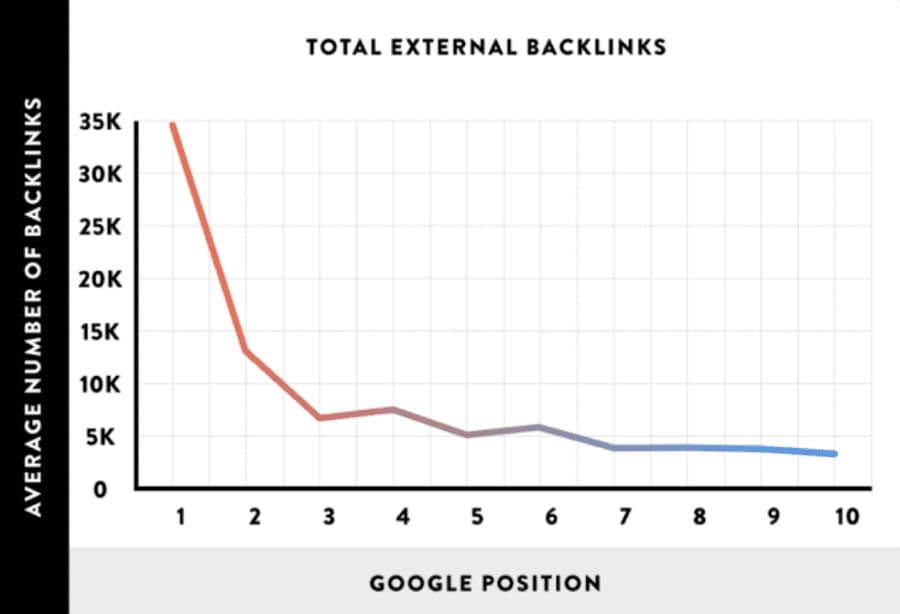Quality link building can make or break your content marketing strategy.
Essentially, links between and within websites are like the bloodstream of the internet. They play a significant role in determining which sites die, survive, and thrive amid the sea of competing content.
But what is link building? Why is it essential for Search Engine Optimization (SEO)?
And, most importantly, how can you leverage it effectively for the best chance of ranking highly in search engines?
Below, we’ll explore all of this and more. Including 5 of the best beginner-friendly link building strategies for you to consider in your digital marketing strategy.
Are you ready?
Let’s begin.

What Is Link Building?
Link building typically refers to a specialized process where websites acquire backlinks from other sites.
And backlinks (also called inbound links) are external links leading to your website from third-party domains.
You’ll find that link building falls under two categories: white hat and black hat.
White hat is the “ethical” way to build links using SEO techniques and linking to relevant content to benefit readers — great.
Meanwhile, black hat link building leverages shady, spam-oriented techniques that don’t add anything valuable to online content — not so great!
Let’s focus on the legitimate white hat techniques in this post.
But first…
Why Is Link Building Important?

As stated before, backlinks are like the internet’s bloodstream, carrying traffic and link equity (or “link juice”) between web pages.
They are a major ranking factor for Google and other search engines since they promote SEO and increase site authority.
They also lead readers to relevant content that can help satisfy their search intent, which is critical to rank in search engines like Google.
In fact, Google confirmed years ago that backlinks from quality websites are among the three strongest ranking factors.
Yet, backlink building can be one of the most challenging parts of SEO, which is likely why 66.31% of web pages don’t have any backlinks to their content.
But don’t be discouraged!
Just because link building is labeled complex, it doesn’t mean it has to be.
So, we’re going to show you how you can tackle the link building process with ease.
5 Top Link Building Strategies That’ll Help You Rank On Google This Year
There are several ways to start your link building campaign to the top of the search engine results pages (SERPs).
That said, some are more effective than others.
Below, we’ll explore five of the most useful methods to add to your content marketing strategy and earn those valuable backlinks.
1. Internal Linking

People generally think of backlinks first when regarding link building, as they’re critical for ranking in Google.
However, internal link building (or internal linking) also plays a major role in page and overall website SEO, making it another significant ranking factor.
The process involves linking one page to another within your website.
Essentially, it creates a giant web of connected content for crawlers and readers to go through.
Easy enough to understand, right?
If not, here’s an example:
Say you have a post targeting the keyword “how to get healthy,” and it has a section on exercise.
Say you also have a post about “great exercise tips.”
You could easily create links between those two relevant pages to bridge the content. So when someone reads one page, they might find and read the other one.
Internal links also enhance website navigation by connecting individual posts to a main page, like the homepage.
Ideally, every page on your website or blog should have at least 3–4 internal links to other pages.
When it comes to internal link building, keep in mind the following key factors…
Write Relevant Anchor Text
One of the most critical elements of internal link building (or any link building) is using relevant anchor text for your hyperlinks.
Anchor text is the words, characters, or phrases you use to link to other content.
Do you see how the word “hyperlinks” above is linked to another Smart Blogger post about how to make hyperlinks?
“Hyperlinks” is the anchor text. The URL behind it is the link to the relevant content.
Relevant anchor text is essential for two key reasons:
- It tells readers what they’ll likely find if they click on the link.
- It can increase your post’s relevance for the anchor text if it’s a keyword.
In short, use your anchor text strategically.
Use Tools

Locating all internal link opportunities within your posts can be a hassle.
Thankfully, plenty of great link building tools are available to make your life easier.
We highly recommend Ahref’s “Link Opportunities” tool alongside their specialized Site Audit function.
That said, Ahrefs is an expensive program.
If you’re looking for a cheaper alternative and you’ve built your website via WordPress, several top-quality plugins can help you locate link opportunities.
Repurpose Your Old Content
Some of your blog posts naturally perform better than others.
Maybe they appealed more to your target audience, offered better value for readers, or just covered the right topic at the right time.
Either way, keep track of your posts with the best performance.
Why?
Because they make excellent internal linking opportunities!
For example, when writing a new post, you can link to relevant and high-performing posts (even if they’re older).
You’ll build your internal link web, improve your website navigation, and boost your SEO.
2. Guest Blogging

If you want to obtain quality backlinks from high-authority websites, guest blogging (or guest posting) is a fantastic link building strategy.
Although it’ll take a lot of time and effort, it can be worthwhile.
When you create valuable content for another website to publish, the post typically includes an author bio, which you can use to link back to your website or blog.
If some of your blog posts are relevant to the content in your guest post, you might even be allowed to link to your own content if it’s deemed valuable.
Not only does guest blogging offer a way to obtain some quality backlinks, but it also attracts new readers to your blog or website.
The best part? It’s super easy to do!
All you need is to:
- Look for guest blogging opportunities for blogs in your niche
- Follow any guest posting guidelines they have
- Offer up a quality piece of content for them to use
While not every blog will agree to publish your post, you’ll eventually find someone willing to give you a chance.
That said, you’ll want to consider a few specific factors if link building is your goal…
Links Must Be Relevant
A link’s quality depends on several factors, but relevance is one of the most important for SEO best practices.
When you create a guest blog post, you should ensure that any link to your content is relevant (and allowed by the website’s owner).
Using irrelevant links can cause unwanted hassle, such as lowering your guest post’s overall quality and SEO.
It can also damage your relationship with the website owner — losing a partner and valuable links.
Links From Your Author Bio
Writing a stellar author bio can be tricky.
But it’s an excellent way to earn a quality backlink while promoting your website or blog to a new audience.
Backlinks from a clear and concise author bio can:
- Increase your website’s authority and SEO (and therefore its overall Google ranking)
- Lead new readers to your content and expand your website traffic
To learn how to write a top-quality author bio for your future guest posts, check out this Smart Blogger guide.
It covers all of the dos and don’ts of effective author bio creation, along with some helpful examples.
Use Social Media
Promote your guest post on your social media accounts.
As soon as your post is published, discuss it on Facebook, Twitter, Instagram, or any other social networks you use.
You can even talk about it on LinkedIn, which may bring you new guest blogging opportunities.
3. Cold Outreach: Asking Other Bloggers For Links

While the term “cold outreach” generally applies to the realm of sales and marketing, it’s also a vital component of link building.
After all, a big part of link building is “marketing” your valuable web content.
Cold outreach involves writing a personalized email to a blog, website, or influencer that you haven’t contacted before to:
- Start building a relationship
- Ask for backlinks from their site
But while the process sounds simple, it involves more than you might expect.
Plus, you’ll likely get a lot of rejections or have your emails outright ignored if you don’t use the right approach.
So, take inspiration from Investis Digital and consider:
- Email simplicity, directness, and formatting
- Email personalization and customization
- An effective value proposition
- Offering well-written, relevant content
- Follow up efforts
As you can probably guess, it’ll take a while for your cold outreach strategy to bear some fruit from your hard labor.
However, you can employ a few best practices to increase your chances of getting a successful reply — and those sweet backlinks.
Let’s explore three of the most effective cold outreach tactics you should employ in your link building efforts.
Find Broken Links

Instead of sending an email asking a blog or website to link to your content, consider offering something of value for their site first.
For example, many blogs and websites have broken links. You can easily find them by using the right tools, such as:
- Semrush
- Ahrefs Broken Link Checker
- Google Webmaster
Once you find a broken link, send an email offering to fix it (ideally by linking to a relevant piece of your own content).
Finding and offering to fix broken links is called broken link building.
Find Unlinked Mentions
Sometimes, blogs, websites, or influencers will mention your content, products, or services without directly linking to you.
These instances are called “unlinked mentions,” which you can search for using tools like:
- Semrush Surround Sound
- Ahrefs’ Content Explorer
Once you locate these unlinked mentions, email the blog or website admin and provide a link they can use in the mention.
This tactic can earn your website a lot of backlinks very quickly, depending on how many unlinked mentions you can locate.
Find Relevant Content
With a bit of research, you can find several blog posts and articles with content that’s relevant to yours.
If these posts don’t already have plenty of links, reach out with an email and offer a link to your work. Explain how it can help enhance their post.
That said, you may feel tempted to offer a “link exchange” since your content is relevant to each other.
Don’t do this.
While exchanging links sounds like a good idea, it’s against Google’s guidelines and can harm both sites’ SEO.
Additionally, don’t pay for backlinks, which many of the sites may request.
It’s a black hat technique you should avoid.
Say “no thank you,” and move along.
4. Warm Outreach: Building Relationships
Warm outreach is also known as “relationship-based” link building.
While cold outreach is contacting websites for the first time, warm outreach involves contacting ones you already have connections with.
Like cold outreach, it also doesn’t involve asking for links directly.
The goal is to get closer to those contacts and build trust, which can lead to natural backlinks you don’t have to request directly.
While building and maintaining relationships for link building often takes a lot of time, it’s a more reliable strategy in the long term.
For example, if you play your cards right, cold outreach may get you one or two backlinks.
However, quality relationships with high-authority sites and creators can net you a lot more over time.
Like cold outreach, you can leverage several best practices to promote a successful warm outreach campaign.
Some of the most effective strategies are to…
Share Content
If you want a strong relationship with a prospective backlink provider, don’t be afraid to share their content or discuss it in your work.
Sharing their content is a great way to get other blogs, websites, and influencers to notice you, especially if you do it regularly (just don’t go overboard).
You especially want to share content if it’s relevant to yours since it has the added benefit of driving new readers to your blog.
Eventually, that content creator may start sharing (or even linking to) your content.
Engage on Social Media

Repeated social media engagement is a great way to build a quality relationship with blogs, websites, and influencers from whom you want links.
Yet, don’t spam social networks daily, talking about how great they are.
Leave regular feedback, and discuss how much you like their content, products, and services.
Keep it cool, and don’t be afraid to play the long game.
Eventually, you’ll start to see some responses and maybe a few backlinks sent your way without asking for them.
Leave Impactful and Encouraging Comments on Their Site
Any quality website knows that engagement is a big part of online success.
So why not take advantage of the fact and directly engage with your ideal backlink providers on their content?
Join their email newsletter and subscribe to their blog. Read their published posts and actively engage with their content by leaving comments.
Not only will this help you build a relationship with that blog or website, but it can drive traffic to your own blog and help showcase your expertise.
Link Baiting
It should go without saying that a major part of any link building strategy is creating unique, valuable content that other sites and blogs inherently want to link to.
But why not take that a step further?
If you want to rake in some backlinks, consider creating content designed specifically for getting them, also called “link bait.”
Then, let your ideal backlink targets know it exists to see if they’ll voluntarily link to that content.
You can also promote your link bait via social media, press releases, and email outreach campaigns.
When made and leveraged correctly, link bait can earn a bunch of high-authority backlinks quickly. This can considerably impact your Google rankings and organic search traffic.
But how do you craft an ideal piece of link bait (or, better yet, several)?
It’s easier than you might think!
Most link bait falls into a few categories and features, including:
- Visuals (like images, charts, graphs, etc.)
- Interactive web assets
- Long-form or comprehensive guides
- Data from legitimate studies and surveys
- Talking point or controversial content
People link to several types of content, though the most effective is one of the three below…
Infographics
Humans are highly visual creatures by nature.
Because of that, we generally prefer looking at colorful images over blocky paragraphs or plain tables of dull, uninteresting data.
That’s why people love infographics — and why websites love linking to them.
Infographics are ideal link bait because they:
- Let you cover larger topics in an exciting and approachable way
- Allow readers to scan and absorb information quickly
- Help give authority to a post by including clear data
So if you want to earn some backlinks quickly, start making some quality infographics.
Quizzes and Games

It’s easy for people to get bored reading through long paragraphs.
While infographics and other visuals can help, you can keep readers engaged by offering interactive content, like quizzes or games.
While this doesn’t work with every type of blog or website, games, and quizzes can yield massive backlink returns if you implement them correctly.
Especially if you offer rewards for finishing the quiz or game.
Videos
High-quality video content is excellent link bait.
Consider how often you’ve shared a video with a friend or family member or linked to one in your web content.
Videos take all of the benefits of infographic content and put it into an even easier-to-digest form for your readers.
They also take a lot of forms, including:
- Tutorials
- Video opinion posts
- Expert interviews
- Webinars or event replays
Thanks to smartphones and free editing software, videos are also easier to make!
Get Ready to Take Your Link Building Strategy to The Next Level

You made it!
Congrats.
So, are you ready to take the web by storm and top Google’s search engine results?
Of course, you are. Otherwise, why else would you be here?
Consider the link building strategies above and start building your winning formula.
Before you know it, you’ll have developed a solid web of links that’ll skyrocket your site’s SEO while appealing to crawlers and readers alike.
The post Link Building: 5 Simple SEO Strategies for 2023 (& Beyond) appeared first on Smart Blogger.

No comments:
Post a Comment